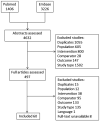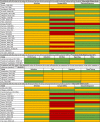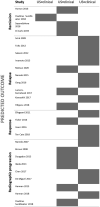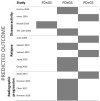Musculoskeletal ultrasound for treating rheumatoid arthritis to target-a systematic literature review
- PMID: 35512175
- PMCID: PMC9707059
- DOI: 10.1093/rheumatology/keac261
Musculoskeletal ultrasound for treating rheumatoid arthritis to target-a systematic literature review
Abstract
Objective: We aimed to systematically review the literature to retrieve evidence on the diagnostic and prognostic value of musculoskeletal ultrasound for a treat to target (T2T) approach in RA.
Methods: Eight research questions were developed addressing the role of ultrasound (including different ultrasound scores and elementary lesions) for diagnosis, monitoring and prognosis of RA. PubMed and EMBASE were searched (2005-2020). Articles on RA and reporting data on musculoskeletal ultrasound were included and extracted according to the underlying questions, and risk of bias assessed according to the study design.
Results: Out of 4632 records, 60 articles were included. Due to clinical heterogeneity, meta-analysis was not possible. Ultrasound better predicted disease relapses with respect to clinical examination in patients in remission, while both methods performed similarly in predicting response to therapy, achievement of remission and radiographic progression. Ultrasound was superior to clinical examination in diagnosing joint involvement using another imaging modality, such as magnetic resonance imaging, as reference. Limited ultrasound scores performed like more extensive evaluations for the detection of joint inflammation and for outcome prediction. Higher ultrasound scores of synovitis were linked to poor outcomes at all disease stages, but a specific cut-off distinguishing between low- and high-risk groups did not emerge.
Conclusions: These data confirm the pivotal role of ultrasound when evaluating synovial inflammation and when identifying RA patients at higher risk of relapse. Further research is needed to better define the role of ultrasound in a T2T management strategy in moderately-to-highly active RA.
Keywords: RA; diagnosis; imaging; prediction; prognosis; systematic literature review; ultrasound.
© The Author(s) 2022. Published by Oxford University Press on behalf of the British Society for Rheumatology.
Figures




References
-
- Smolen JS, Landewé RBM, Bijlsma JWJ. et al. EULAR recommendations for the management of rheumatoid arthritis with synthetic and biological disease-modifying antirheumatic drugs: 2019 update. Ann Rheum Dis 2020;79:685–99. - PubMed
-
- Silvagni E, Giollo A, Sakellariou G. et al. One year in review 2020: novelties in the treatment of rheumatoid arthritis. Clin Exp Rheumatol 2020;38:181–94. - PubMed
-
- Silvagni E, Sakellariou G, Bortoluzzi A. et al. One year in review 2021: novelties in the treatment of rheumatoid arthritis. Clin Exp Rheumatol 2021;39:705–20. - PubMed
-
- Singh JA, Saag KG, Bridges SL. et al. 2015 American College of Rheumatology guideline for the treatment of rheumatoid arthritis: ACR RA treatment recommendations. Arthritis Care Res 2016;68:1–25. - PubMed
Publication types
MeSH terms
LinkOut - more resources
Full Text Sources
Medical

